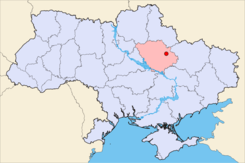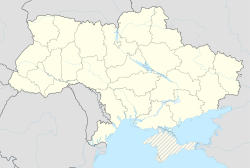Dikanka
|
Dykanka Диканька |
|||
|---|---|---|---|

Landscape with Holy Trinity Church
|
|||
|
|||
 Location of Dykanka within the Ukraine |
|||
| Location of Dykanka | |||
| Coordinates: 49°49′14″N 34°31′47″E / 49.82056°N 34.52972°ECoordinates: 49°49′14″N 34°31′47″E / 49.82056°N 34.52972°E | |||
| Country |
|
||
| Oblast |
|
||
| Raion | Dykanskyi Raion | ||
| Founded | 1658 | ||
| Area | |||
| • Total | 11.74 km2 (4.53 sq mi) | ||
| Elevation | 72 m (236 ft) | ||
| Population (2015) | |||
| • Total | 7,789 | ||
| Time zone | EET (UTC+2) | ||
| • Summer (DST) | EEST (UTC+3) | ||
| Postal code | 38502 | ||
| Area code(s) | 5351 | ||
| Licence plate | BI | ||
Dykanka (Ukrainian: Диканька) is the urban settlement in Dykanskyi Raion (district), Poltava Oblast (province) of central Ukraine. Its population is 7,789 (2015 est.).
The settlement is located 29 km (18 mi) from the rail station in Poltava.
Dykanka was first mentioned in 1658 as a small village, though the area was populated for centuries.
Within modern Dykanka at different times had traces of settlements of Scythians. Also found the remains of a settlement from the ashes. Found the remains of two settlements VII-VI centuries BC.
In 1430 the land got Tatar Murza Leksada Mansurksanovych, the future Prince Alexander Glinski, and, according to Leo Padalka and other pre-revolutionary (before 1917) historians Dykanka was among his ″settlements″.
It has held the status of urban-type settlement since 1957.
Dykanka is the location of the short story collection Evenings on a Farm Near Dikanka by Nikolai Gogol.
The facade of the palace of the estate Kochubeys in Dykanka. The architect Giacomo Quarenghi. Picture the end of 19th century
Triumphal Arch. The architect - the academician of architecture Luigi Rusca, 1820
Church of the Holy Trinity, 1780. Late Baroque. The architect of N. A. Lvov (?)
Church of St. Nicholas in the urban settlement Dykanka. The architect of N. A. Lvov, 1797
The bell tower of St. Nicholas Church. Architect Luigi Rusca, 1810-1827. Postcard late 19th century
Lilac Grove in Dykanka. The former estate of Prince Kochubey. Laid down in the early 19th century
...
Wikipedia



